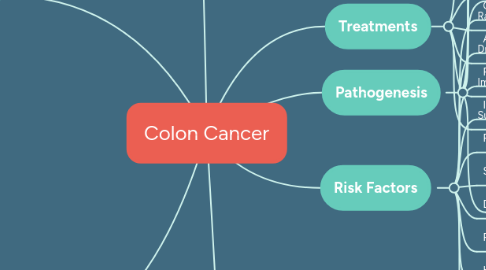
1. Incidence/Prevalence
1.1. Many cancer patients consider length of life and quality of life to be two of the most important measures of cancer care.
1.2. 95,520 new cases of colon cancer in 2017
1.2.1. 47,700 men and 47,820 women
1.3. Median age for diagnosis is 68 for men and 72 for men
1.4. 30% chance higher in men
1.5. Colon cancer incidence increased from 1975-mid 1980s and has generally decreased due to changing risk factors.
2. Diagnostics
2.1. Screenings are necessary around the age of 45 unless colon cancer runs in the family or you’ve had prior issues.
2.2. Colonoscopies allow doctors to remove growth in colon before becoming cancerous.
2.3. Positive stool tests are needed to have a follow up colonoscopy
3. Clinical Manifestations
3.1. Change in bowel habits
3.1.1. You may feel that your bowel doesn’t empty completely
3.2. Constipation
3.2.1. May experience stools that are thinner than normal
3.3. Change in consistency of stool that lasts longer than four weeks
3.4. Rectal bleeding or blood in stool
3.5. Abdominal discomfort, diarrhea, cramps, gas, or pain
3.6. Weakness/ fatigue
3.6.1. Nausea and vomiting may be a leading cause
3.7. Unexplained weight loss
3.7.1. This can be due to loss of appetite
4. References
4.1. Cooper, J. A., Parsons, N., Stinton, C., Mathews, C., Smith, S., Halloran, S. P., . . . Taylor-Phillips, S. (2017, November 02). Risk-adjusted colorectal cancer screening using the FIT and routine screening data: development of a risk prediction model. Retrieved November 14, 2017, from https://www.nature.com/articles/bjc2017375
4.2. Rabin, R. C. (2017, August 22). More Young People Are Dying of Colon Cancer. Retrieved November 14, 2017, from https://www.nytimes.com/2017/08/22/well/live/more-young-people-are-dying-of-colon-cancer.html
5. Pathogenesis
5.1. Environmental factors
5.1.1. This includes lifestyle choices such as smoking, drinking, or failing to exercise regularly.
5.1.2. Obesity and a diet high in fat while low in fiber
5.1.2.1. Individuals who consume large amounts of red meat in their diet also increases their risk of developing colon cancer
5.2. Errors in genetic blueprint in DNA.
5.3. Cells continue to divide even when new cells aren’t needed.
5.4. Tumor is formed due to cells accumulating.
5.5. Cancer cells grow to invade and destroy normal tissue nearby.
5.6. Stages of Colon Cancer
5.6.1. Stage 0
5.6.1.1. Carcinoma in situ and the cancer has not grown beyond the inner layer of the colon.
5.6.2. Stage I
5.6.2.1. The cancer has grown through the muscularis mucosa and into the submucosa.
5.6.3. Stage II
5.6.3.1. IIA
5.6.3.1.1. The cancer has grown into the outermost layers of the colon, but has not grown through them.
5.6.3.2. IIB
5.6.3.2.1. The cancer has grown through all of the layers of the colon, but has not grown into other organs or tissues.
5.6.3.3. IIC
5.6.3.3.1. The cancer has grown through all of the layers of the colon and into nearby organs or tissues.
5.6.4. Stage III
5.6.4.1. IIIA
5.6.4.1.1. The cancer has grown into the submucosa. It may have also grown in to the muscularis propria. The cancer has spread to 1-3 lymph nodes near the site of the primary tumor, but hasn’t spread to distant sites.
5.6.4.2. IIIB
5.6.4.2.1. The cancer has grown into the outermost layer of the colon, but has not reached nearby organs or it has grown through the wall of the colon and into nearby organs or tissues. 1-3 lymph nodes have been spread to.
5.6.4.3. IIIC
5.6.4.3.1. The cancer may or may not have grown through the wall of the colon, but has spread to four or more lymph nodes near the primary site.
5.6.5. Stage IV
5.6.5.1. The most advanced stage of colon cancer. It means the cancer has metastasized to distant sites, such as the liver or lungs. The cancer may or may not have grown through the wall of the colon, and lymph nodes may or may not be affected.
5.6.5.1.1. Stage IVA
5.6.5.1.2. Stage IVB
5.6.6. Recurrent
5.6.6.1. When colon cancer returns after it has been treated and gone undetected for a period of time.
6. Risk Factors
6.1. Old age
6.2. African-American Race
6.3. Personal history of colon cancer or polyps
6.4. Inflammatory intestinal conditions
6.5. Family History
6.6. Sedentary lifestyle
6.6.1. This can lead to obesity
6.7. Diabetes
6.7.1. Type II diabetes is associated with a higher risk of colon cancer
6.8. Radiation Therapy
6.9. History of inflammatory bowel disease (IBD)
6.9.1. This includes ulcerative colitis and Crohn’s disease
6.10. Lifestyle choices
6.10.1. Smoking
6.10.2. Consuming alcohol
6.10.3. Eating. A low fiber, high fat diet
7. Treatments
7.1. Surgery for invasive or advanced cancer
7.2. Chemotherapy- therapy that uses drugs to destroy cancer cells
7.3. Radiation- therapy that uses energy sources including x-rays to kill cancer cells and to shrink large tumors before operation
7.4. Drug therapy- drugs such as Avastin, Cyramza, Vectibix, etc.
7.4.1. This is also known as targeted therapy
7.5. Immunotherapy- patients benefit with antibodies such as pembrolizumab
7.6. Supportive care- palliative care focuses on providing relief from pain
7.6.1. All staff working with the patient needs to be fully on board and supportive of whatever the patient’s wishes are
